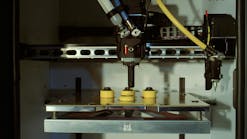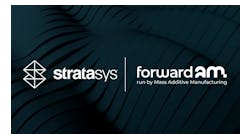
Bob Crawford, 67, retired in May as VP of engineering for auxiliary equipment supplier Universal Dynamics Inc., Fredericksburg, Va. His career spanned more than 40 years, with his name appearing
on several patents, including for the PCT-2/3 drying system, which is an important component of the company's twin-tower dehumidifier for PET preform production. Crawford's entry into the industry came after he earned his bachelor's degree in production management from the University of Maryland, when he was intrigued by the opportunities and growth in the specialized field. Una-Dyn President Bill Goldfarb said that Crawford has left a long legacy of machine designs.
"Bob's impact to Una-Dyn and the plastics industry has been immeasurable," Goldfarb said. "His practical engineering knowledge and machine-design acumen, fortified by a generation of processing experience and coupled with the ability to proficiently execute solutions, made Bob an invaluable asset and key contributor to Una-Dyn's success and market position."
Crawford now is operating his own consulting business in Stafford, Va., and offering training. He recently discussed his career with Plastics Machinery Magazine Managing Editor Angie DeRosa.
When you were studying production management, did you ever imagine that you would end up in the plastics industry?
Crawford: My interest in production management was to be involved in manufacturing at some level. Going into the plastics industry was a fortunate opportunity developed from my initial job interview with Una-Dyn. I started working for Ernest May Jr. and Dewey Rainville after graduation.
What led you to a career in the plastics industry?
Crawford: In the 1970s, the plastics industry was experiencing rapid growth both in volume, but also in technology. I was able to find a niche where we developed products in the auxiliary equipment market that were very progressive. The management opportunity and progressive growth in a specialized field was a personally rewarding experience.
Where does your inspiration come from when developing or improving equipment?
Crawford: Most of the time we begin with a situation brought forward by a customer or a need developed through collaborative effort, and we work from that point to develop a solution. Often the issue would be described in a high-level comment that we could distill into a more specific solution.
You were appointed VP of engineering in 1993. Under your tenure, what was your biggest accomplishment?
Crawford: The most important thing we developed as a company was the ability to bring together the CAD design systems, and coordinate with laser-cutting and CNC forming machines to be able to build a standard line of equipment, but with the ability to customize for the exact requirements of the user when required. We are able to make larger systems than we normally offered or very specialized things beyond the standard lines.
What was the biggest advancement in auxiliary equipment during your career?
Crawford: I believe most of the fundamental elements of the machines were well-established by the 1980s, and the more important concern was information and knowledge concerning the operation of the auxiliary systems. For our part, the introduction of the Una-Dyn FACS [control and monitoring] system enabled connection of the various parts of the resin-handling system and afforded remote visibility for managers to keep track of [their] operation.
How has Industry 4.0 evolved, and do you see auxiliary equipment as the main driver of preventive and predictive maintenance?
Crawford: I think all elements of the process system will benefit from increased connectivity and advanced operator interfaces to better control and, when necessary, repair or correct operations before downtime or productivity losses occur.
You played a crucial role in transferring technology from Italy to the U.S. when Piovan purchased Una-Dyn in 2008. What do you believe has been the most innovative technology or technologies resulting from that transfer?
Crawford: Una-Dyn is now manufacturing the Piovan blending lines, along with the PET process drying hoppers. The next steps will be the whole PET drying system and the water equipment, in particular the Nextcool advanced mold-temperature-control systems.
There is such a skills shortage for manufacturing in general, and in plastics processing in particular. What role do you see auxiliary equipment innovations playing in addressing that?
Crawford: Having more self-diagnostics and automatic system adjustment to optimize the process. As we know, there have been tremendous improvements in process machine optimization over the recent years. Integration of the auxiliary systems as part of the process optimization would enable a higher level of overall process control. On the other hand, the industry does need to address the technology and skill requirements through education and programs both for engineers and technicians, as well as operational-level employees. There are many new tools available to understand the systems that would have taken many years of experience to learn in the past.
Let's talk about executing Una-Dyn's massive recent move from Woodbridge, Va., to Fredericksburg. What are the biggest achievements from that move?
Crawford: My role in the move was mostly in the planning for the new facility. Una-Dyn was located in the same facility from 1968 until this move, which had many constraints both in optimum production layout and the inability to expand the plant floor due to the limits of the property. When the company moved to Woodbridge, it was a relatively undeveloped area 20 miles south of downtown Washington, D.C. Today that area is part of the greater Washington metropolitan area, and as a consequence, was no longer an optimum choice for our manufacturing plant.
The new facility is in a single, larger manufacturing building with enough land to expand in the future. This will enable the Piovan group to expand their product lines in the North American markets.
What benefits do you expect to receive from the relocation?
Crawford: Probably the most significant benefit of the move will be a kaizen rework of the production-floor layout. When Piovan first acquired Una-Dyn, they had just completed a total kaizen event at their main production facility with excellent results. We wanted to make similar gains in the quality of our production environment.
Would you advise your grandchildren to go into the plastics industry?
Crawford: My wife and I have four wonderful grandchildren who are all teenagers at this time. We started them out with industry-related knowledge from the time they were in kindergarten. They all learned about plastics recycling and biopolymers when they started school. While I don't know if they will have as direct a connection to plastics as I have had, they have had some exposure from things they learned about the industry and the presence of plastics in our everyday lives.
What would you like to be remembered for?
Crawford: I was very fortunate to join the industry while it was growing at a high rate of expansion both in technology and volume. Una-Dyn was able to develop a wide-ranging ability to provide solutions to our customers that others would not supply. Our ability to provide these systems enabled us to better support our customers in their endeavors.








